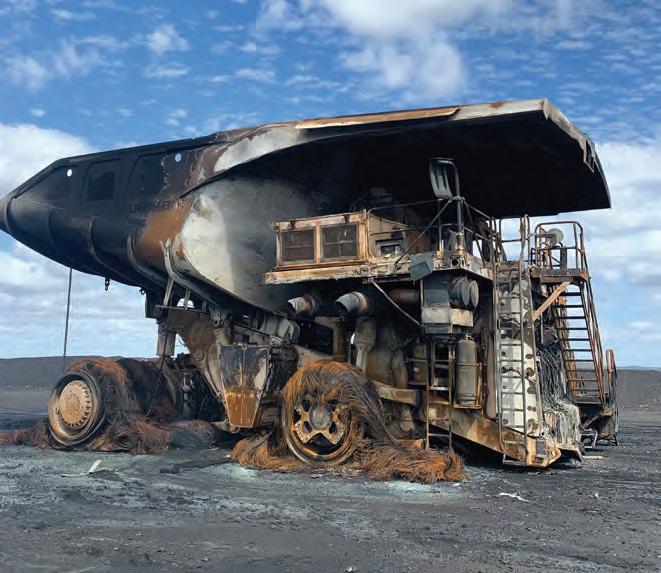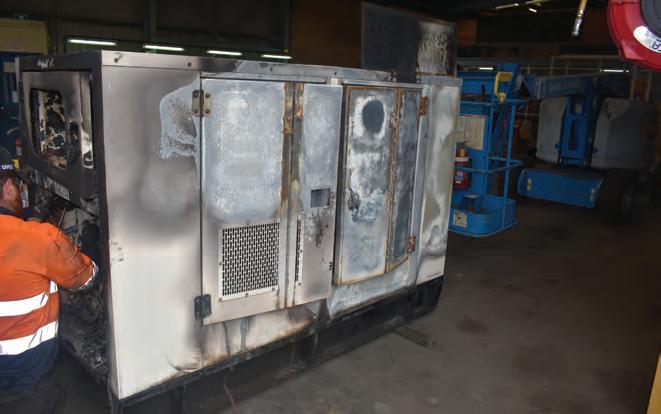
5 minute read
The heat is on to stay safe
FIRE FORENSICS IS AN EXPERT FIRE INVESTIGATION COMPANY WHICH HAS DEALT WITH NUMEROUS INCIDENTS AT MINE SITES ACROSS THE GLOBE.
In Australia, mine sites face strict regulations to ensure operations are undertaken safely. With countless variables requiring consideration at these sites every day, sometimes incidents do occur.
The dangers surrounding heavy mining equipment are often associated with collisions and operator error.
Yet certain factors, such as flammable liquids meeting hot surfaces on these vehicles, can lead to them catching on fire. Other kinds of mobile and stationary equipment can also catch fire.
It can be difficult for the workers on site to determine the true nature of what caused a fire to start, and it often requires bringing in a specialist.
Fire Forensics has been solving these cases since 2017, with experience in the mining industry, private and public sectors. It was founded by Jim Munday, who brought his experience of conducting forensic fire investigations in the United Kingdom’s public sector to the company.
“Fire Forensics is a relatively new company. It was founded based on a smaller business – JW Munday and Associates – which was a partnership between myself and my wife started in 1998,” Munday tells Safe to Work.
“Using our expertise that had been developed over 20-plus years of working in the public sector, we thought it was a good idea to make that available to private clients. There were always issues with private clients getting hold of good quality fire investigation.”
Munday and his wife moved their business to New South Wales in 2003. He says they initially provided services to insurance companies and legal representatives in the civil and criminal area, and quickly expanded into mining and heavy machinery fires.
“We had a wide base and built the business up from there; at that stage I started to see there was a need for a high-quality fire investigation with a forensic mindset that wasn’t always readily available to clients across Australia,” he says.
By 2010, demand for the company had grown significantly and Munday recruited more fire forensic experts, including nowmanaging director Belinda (BJ) Jones.
“In 2017, we decided as part of my retirement succession planning to form Fire Forensics as a company,” Munday says.
Fire Forensics focusses on fire and explosion investigation in Australia and abroad, with its findings determining how a fire started and how future fires can be prevented by using scientific data.
Munday says the company has points of difference from some of the other suppliers in the market that clients seemed to appreciate.
“We are very committed to the scientific process and objectively analysing the facts and material before forming an opinion. We’re also committed to explaining our findings very clearly in basic terms without going into technical jargon,” Munday says.
Fire Forensics uses its understanding of fire dynamics, and fuel and ventilation factors to trace fires back to where the ignition occurred.
“If a fire is not tremendously large, very often some sort of internal investigation
Fire Forensics’ investigations help to determine the cause of a fire.
might be done and someone might point to something as the cause,” he says.
“They may think they can see what’s going on but often they can’t see the bigger picture.”
Munday says many fires on mine sites are caused by fuel leaking onto hot surfaces of diesel engines, which requires knowledge of exhaust and ventilation behaviours.
The company investigates many fires due to ignitable liquid fuels which are not where they’re supposed to be.
“Both the actual fuel from the engine, but also hydraulic oil under pressure behaves as an ignitable liquid and very often the ignition source for escaping liquid is a hot surface, such as the exhaust or the turbo charger,” he says.
“When the liquid droplets spray around and they come into contact with the hot surface, you can get an ignition which may be a long way from the leak.”
Fire Forensics also inspects identical undamaged equipment on site during investigations to determine the sequence of events that could have led to a fire.
One incident involved a water cart at a coal mine. The damage showed that the fire had started around one cylinder head, but the cause of the ignition was unknown.
Upon examining a similar truck, Fire Forensics discovered a build-up of oil from a leaking cylinder head, which combined with coal dust caked onto the exhaust.
“When I looked at an identical machine, there were leaking oil seals on its engine and build-up of oil alongside the exhaust manifold. Compounding that was the working environment which had a lot of coal dust,” Munday says.
“The combination of coal dust and oil built up on the exhaust manifold in exactly the same place where the fire started on the truck that was burnt determined the most plausible cause for this fire.”
Fire Forensics offers secondary examinations such as documentary, photographic and video evidence and witness accounts to support its core expertise.
Munday says if a case goes to court, the company can be involved in various stages beyond preparing the report, such as conferences with solicitors and barristers before the case is heard.
“If required, we then give evidence as witnesses in the hearing. We’re allowed to give opinions based on all the evidence including witness statements,” he says.
The company’s next focus will be on the growing presence of batteryelectric vehicles, which come with their own challenges in determining how a fire could ignite.
As mining moves towards fully electric operations, Munday says the industry will have to stay at the forefront of battery technology and energy storage.
“We’re learning a lot about that very quickly – I think that’s going to be a growth area for us in the future,” Munday says.
“It’s much more difficult to be certain the fire has been completely put out or if all energy has been discharged before examination, which is something firefighters are dealing with at the moment.”

Fires on mine sites can be caused by fuel leaking onto hot surfaces. Fire Forensics was founded by Jim Munday.











